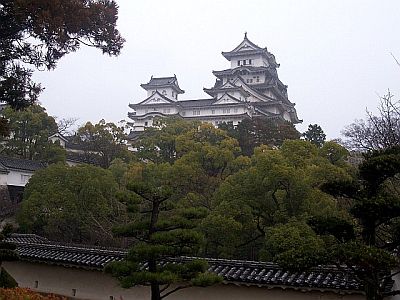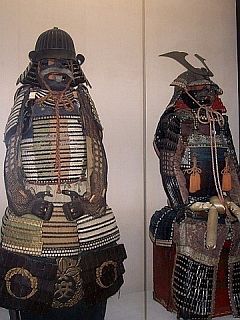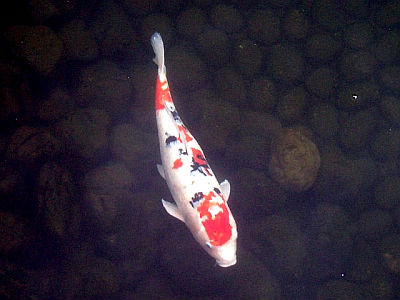
Japan
Himeji![[Unesco]](/images/unesco-logo.gif)
The two great places to visit in Himeji are the castle, classified by Unesco, and the nearby gardens of Koko-en. You can leave your luggage in a locker of the JR station, located about 20 minutes walk from the castle and gardens. Beaware, the castle could be partially under renovation from 2010 to 2014 (check the dates) with scaffoldings...
Himeji castle
The outside

This medieval castle, nicknamed "White Heron", is classified by Unesco and is a very good example of the architecture of Japanese castles. It is also one of the most, if not the most, beautiful castle in Japan. Built in 1346, it took its present form between 1601 and 1609.
The dungeon is the centerpiece of the castle, surrounded by moats. Sometimes, to deceive the enemy, dungeons were built to let people believe the number of floors was lower than what it was. Thus the dungeon of Himeji Castle appears to have 5 floors but actually there are 6 plus a cellar. One can find a small Shinto altar at the top of the dungeon. The arrow slits could have different geometrical shapes. The walls, fan-shaped, were made to complicate the climbing during an attack. Moreover narrow pathways should make the defense of premises easier. The roofs are decorated with shachi, which is a fabulous animal having power of protecting against fire and evil spirits (have a look at it in the pictures galleries).
Walking around the castle, we arrive at a well which is associated to a yurei ("evanescent spirit", let's say a ghost) legend : This legend says a servant named Okiku overheard a plot to murder her master. She managed to make it failed and so saved her master. In retaliation, the plotters falsely accused her of a larceny. She was then tortured to death and her body was thrown into a well. It is said that her tears still haunt the castle...
The inside

Inside the castle, there is (among other things) a portrait of the monk Daruma (see page Tokyo - Senso-ji temple), various objects and samurais armors.
The samurais were warriors tied to a daimyo (lord, tied himself to a shogun) or shogun (great military leader). They appeared in the 12th century and remained until 1878 because as Japan was closed on itself, Japanese disdained the development of firearms, yet known since the Portuguese brought them in the late 16th century (but there were inaccurate and could not pierce a reinforced armor at that time). The unification of the country under the Momoyama Era in the early 17th century (and so the decrease of wars) did not in fact contribute to the development of firearms either and the "prestige" of the sword kept prevailing (in Europe, chivalry disappeared with the development of firearms). Their code was based on bushido and they took a vow of loyalty to their master. A samurai who left his lord, lost his lord (death...), or misbehaved in battle became ronin. Sometimes, however, some samurais chose to become ronin for a year to be confronted to a life of vagrancy before returning to serve their master. He could make it up to seven times according to the proverb "fall seven times and stand up eight". But the ronins were generally badly regarded by other samurais in a highly hierarchichal society even though there were respected by the lower classes and...feared in the same time. This is because ronins could fight samurais who bullied villagers. Ronins could also become farmers or priests. Nevertheless it was unenviable to be ronin and this term is still used in Japan to describe a student who failed their entrance exam to university or an unemployed person... A famous story in Japan is the one of the "47 ronins". It said that samurais who became ronins after their daimyo had been forced to commit seppuku (ritual suicide also known by its inappropriate name harakiri) for assaulting a court official, decided to avenge him by killing the court official. They ended up sentenced to seppuku... Their tombs are in Sengaku-ji temple in Tokyo.
The movie "Seven samurai" by Akira Kurosawa (1954) inspired John Sturges for an American remake, "the magnificent seven" in 1960.
The armor of the warriors (then samurai), gusokus or yorois, were both light and sturdy. They had evolved since the 4th century to become complete around the year 800. The breastplate and shoulder pads are made of lacquered iron plates fastened with strings of silk. The neck guard in iron was worn to protect from decapitation. The lacquered iron mask (mempo) was worn by the samurai both to impress the enemy and to protect the face (which may break the tip of a arrow for example). The helmet visor (kabuto) protected the top of the head as well as the neck. The helmet bore the emblem of the family of the samurai (kamon) either on the front or on the side flaps, and could be decorated with a maedate. On the photo, we can see on the right a maedate kuwagata (which means stag beetle in Japanese), big metal horns, reserved for high ranked samurai. The Samurai wore two swords at the hip, the katana and wakizashi (sword shorter than the katana which was used for combat in closed places or with limited space). They usually wore baggy pleated trousers : hakama they hugged tightly with leggings when putting their armor.
The katana (uh... well it is better to say nipponto !) is the famous Japanese sword, of exceptional quality.
Koko-en gardens
The Koko-en gardens, close to the castle are typical Japanese gardens, recreating landscapes in miniature. Water is an unavoidable element because it has a role of purification in Shinto. There is also, as it is often the case in gardens, a pavilion for the tea ceremony.

In ornamental lake we can see several koi (or nishigoi, which is the Japanese carp). This carp comes from Black sea, Caspian sea, Aral sea and Azov sea and was brought in China and later on in Japan where it was placed into rice fields of the Niigata region during the 16th century. In the 19th century, several crossbreedings gave them new colors. The most beautiful varieties are found in Japan and can reach very high prices (up to several thousand euros). In addition to having pretty colors, koi can also eat in one's hand and be touched. For Japanese, it is a symbol of courage and perseverance as it is a fish that can swim against the current of a river and even a waterfall... It is also a symbol of longevity because it can live several decades. According to a Chinese legend, a koi swimming against the current in the yellow river flew into the sky and turned into a dragon. This legend would be the origin of the Japanese tradition of attaching koi shaped windsocks at the top of a bamboo pole during the children celebration "Kodomo no hi" : the upper one (black) represents the father, the second one (red) represents the mother and the following represent the children.
